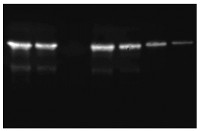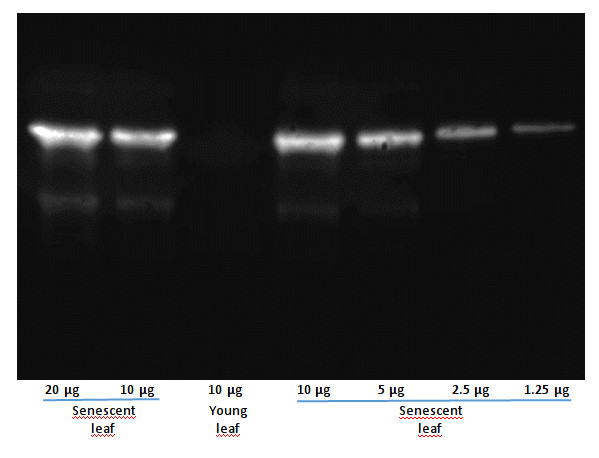1

Anti-SAG12 | Senescence-specific cysteine protease SAG12
AS14 2771 | Clonality: Polyclonal | Host: Rabbit | Reactivity: A. thaliana, H. vulgare, B. napus
- Product Info
-
Immunogen: KLH-conjugated peptide derived from Arabidopsis thaliana SAG12 protein sequence, UniProt:Q38886, TAIR: AT5G45890
Host: Rabbit Clonality: Polyclonal Purity: Immunogen affinity purified serum in PBS pH 7.4. Format: Lyophilized Quantity: 50 µg Reconstitution: For reconstitution add 50 µl of sterile water Storage: Store lyophilized/reconstituted at -20°C; once reconstituted make aliquots to avoid repeated freeze-thaw cycles. Please remember to spin the tubes briefly prior to opening them to avoid any losses that might occur from material adhering to the cap or sides of the tube. Tested applications: Western blot (WB) Recommended dilution: 1 : 2000 (WB) Expected | apparent MW: 38 | 28 kDa
- Reactivity
-
Confirmed reactivity: Arabidopsis thaliana, Brassica napus, Hordeum vulgare Predicted reactivity: Actinidia deliciosa, Brassica rapa, Gossypium hirsutum, Petunia hybrida, Morus notabilis, Nicotiana tabacum, Petunia hybrida, Populus trichocarpa, Ricinus communis, Theobroma cacao
Species of your interest not listed? Contact usNot reactive in: Citrus sinensis - Application Examples
-
Application example
20 - 1.25 µg of soluble proteins from senescing or young leaves of oilseed rape (Brassica napus L.) extracted with citrate sodium-phosphate buffer (100 mM, pH 6.8) and were separated on 12% SDS-PAGE and blotted 10 min to PVDF using semi-dry transfer (see Desclos et al. 2009). Blots were washed with TBS-T 3 times for 15 min at room temperature (RT) with agitation. Blot was incubated in the primary antibody at a dilution of 1: 2 000 (prepared in TBS-T with 5% low fat milk) for 2h or 1h30min at RT with agitation. The antibody solution was decanted and the blot was washed 5 times for 5 min in TBS-T and 3 times for 5 min in TBS at RT with agitation. Blot was incubated in secondary antibody (anti-rabbit IgG horse radish peroxidase conjugated) diluted to 1:0 000 in for 1h at RT with agitation. The blot was washed as above and developed for 5 min with ECL according to the manufacturer's instructions. Exposure time was 1 second.
Desclos M, Etienne P, Coquet L, Jouenne T, Bonnefoy J, Segura R, Reze S, Ourry A, Avice J-C. 2009. A combined 15N tracing/proteomics study in Brassica napus reveals the chronology of proteomics events associated with N remobilisation during leaf senescence induced by nitrate limitation or starvation. Proteomics 9, 3580-3608.
Courtesy of Dr. Jean-christophe Avice, INRA, France - Additional Information
-
Additional information (application): Recommended plant extraction buffer: See Durian et al. (2019). Denature in Laemmli-sample buffer (final concentrations: 5% (v/v) beta-mercaptoethanol, 69 mM Tris-HCl pH 6.8, 11.1% (v/v) glycerol, 2.15 % (v/v) SDS) at 70◦C for 5 min - Background
-
Background: Senescence-specific cysteine protease (SAG12) is a cysteine protease influenced by cytokinin, auxin and sugars and involved in developmental senescence specific cell death. - Product Citations
-
Selected references: Durian et al. (2019). PROTEIN PHOSPHATASE 2A-B' gamma controls Botrytis cinerea resistance and developmental leaf senescence. Plant Physiol. 2019 Oct 28. pii: pp.00893.2019. doi: 10.1104/pp.19.00893.
Durian et al. (2019). PROTEIN PHOSPHATASE 2A-B'? controls Botrytis cinerea resistance and developmental leaf senescence. Plant Physiol. 2019 Oct 28. pii: pp.00893.2019. doi: 10.1104/pp.19.00893.
Frank et al. (2019). The Hordeum vulgare cysteine protease HvPAP14 plays a role in degradation of chloroplast proteins. J Exp Bot. 2019 Aug 12. pii: erz356. doi: 10.1093/jxb/erz356.
- Protocols
-
Agrisera Western Blot protocol and video tutorials
Protocols to work with plant and algal protein extracts
Agrisera Educational Posters Collection - Reviews:
-
This product doesn't have any reviews.



